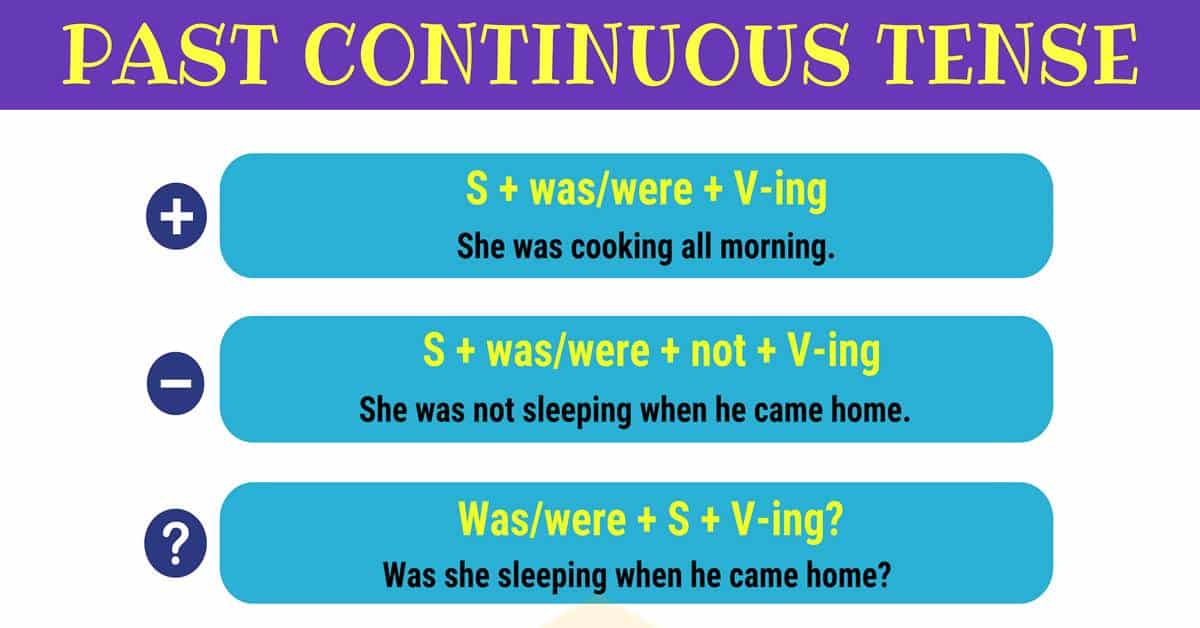Past Continuous Tense! In this section, we are going to be looking at the function of the past continuous tense as well as the rules which we must follow when using it.
Learn how and when to use the Past Continuous Tense (or Past Progressive) in English with useful grammar rules, example sentences and ESL printable worksheets.
Past Continuous Tense
What is the Past Continuous Tense?
The past continuous tense is one which is used very frequently in the English language and is made up of an -ing verb preceded by the past tense of the verb ‘to be.’ For example ‘the animals were running gracefully through the field.’ This is an easy concept to understand and once you have mastered it, you will be able to speak much more freely about the past.
The past continuous, or past progressive, tense describes an action or situation that began in the past and is still going on in the present time.
The past continuous is easily formed by pairing up the verb to be’ with a verb ending in -ed’ instead of -ing’ (e.g. was talking).
The second section below has some great examples of how to use the past continuous tense in actual conversation. After studying those samples, continue reading to the end for some practice choosing the correct form of this verb tense to complete a sentence. When reading a book or article, it is often a great idea to keep a dictionary or thesaurus at hand, especially when encountering unfamiliar or irregular verbs.
Past Continuous Tense Structure
The Past Continuous is used to describe actions that began in the past and often continued for a short period of time after the action started.
The structure of the Past Continuous Tense is:
Was/were + V-ing (Present Participle)
Example:
At three o’clock yesterday, I was working in the garden.
Examples of the Past Continuous Tense
- My kids were playing basketball together for hours yesterday.
- My daughter was planning to join the school band but chose the choir instead.
- I was talking to my neighbor when she told me about the fire that started across the street.
- Our school was holding a pep rally when the fire alarm went off.
- I was not giving to charity last year, but then I received a raise and started contributing to the local animal shelter.
- While I was getting ready for bed, I turned on the news to see what had happened during the day.
- My team was holding an offsite lunch n learn but discontinued it when people stopped showing up.
- My brother was dropping me off at school every morning so I didn’t have to wait in the cold for the bus.
- I was hanging more and more elaborate Christmas lights every year until I realized I couldn’t do anything bigger this year so I stopped.
- My friend was sleeping over every Friday for three months during the Summer but then we had to stop when school started.
How to Use the Past Continuous Tense
The Past Continuous Tense Usage
The past continuous is used:
To describe parallel actions
The past progressive is often used to denote an action that was interrupted by an event, or for two actions taking place in parallel.
Examples:
- While I was washing the dishes, I heard a loud noise.
- While you were washing the dishes, Sue was walking the dog. To express specific Time as an Interruption
To describe what someone was doing at a particular point in time
Example:
I was working in the garden all day yesterday.
That could also be expressed using the simple past, as I worked…, which implies that the action is viewed as a unitary event (although the effective meaning is not very different).
To express interrupted action in the past
Often the past progressive is mixed with the past simple to show what was happening when something happened.
Examples:
- I was driving to work when I crashed my car.
- I watched a movie while I was flying to Dubai.
To describe repetition and irritation
Example:
He was always complaining in class.
Note
For stative verbs that do not use the progressive aspect, the simple past is used instead.
Example:
At three o’clock yesterday we were in the garden.
Time Expressions Used with the Past Progressive Tense
- When
- While
- Always
- Constantly
- At that time
- In those days
- All day
- All evening
- For hours…
Past Progressive Tense Charts | Picture










0 Comments